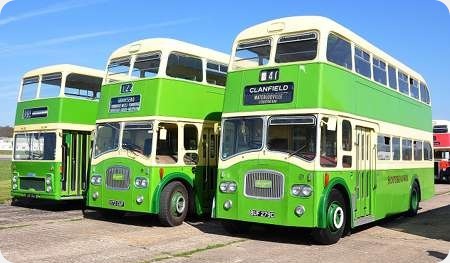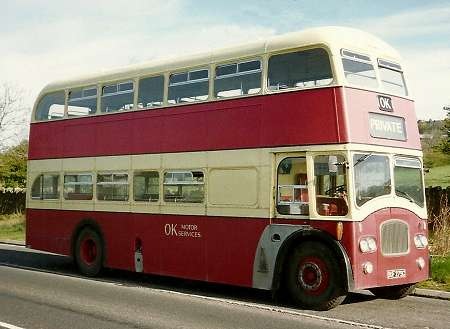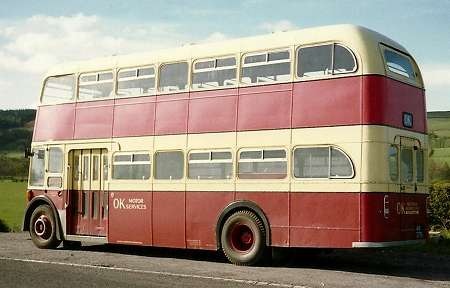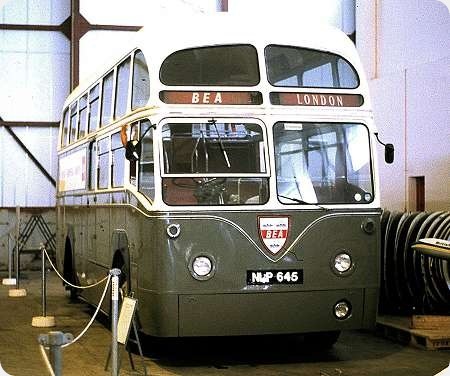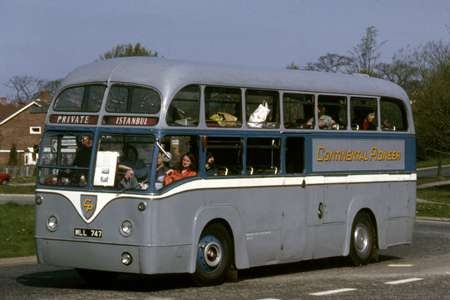Provincial – AEC Regent V – 972 CWL – 60
Provincial (Gosport & Fareham Omnibus Co)
1957
AEC Regent V LD3RA
Park Royal H37/28R
Taken at Hoeford depot on 30/03/69 having been recently transferred from City of Oxford where it had been No H972 this photo shows newly painted Provincial No 60 an LD3RA AEC Regent V with a Park Royal H37/28R body registration number 972 CWL delivered to COMS in December 1957. As a fan of the AEC concealed radiator and the AEC marque in general I find this and the elegant 30ft long Park Royal body an irresistible combination, the only way the effect could be improved would be for it to be in the original superb Oxford livery. This was taken on the same occasion as my posting of the Guy Wulfrunian.
Photograph and Copy contributed by Diesel Dave
14/04/16 – 06:05
Very nice shot Diesel Dave. I too am a fan of the Regent V in all its forms and this is a most handsome version. It would indeed have looked the bees knees in City of Oxford livery, but at least in your photo it’s paintwork looks fresh – probably just repainted out of Provincial’s distinctive ‘jade’ green livery. (Don’t ask me the shade as I haven’t a clue as to what is was officially called!). The NBC leaf green and white also seems to emphasise the length of the AEC nicely, which brings me to the date of the photo Dave, as NBC corporate livery didn’t make its debut until late 1972 I’m afraid. The Regent is wearing the original white ‘Double N’ arrowhead alongside the fleetname. This was replaced some years later by the red and blue arrowhead within a white square. Sadly I did not get to know the Provincial fleet until the early ‘eighties, by which time the fleet was standardising on the Leyland National. Mind you I was fortunate in seeing Provincial’s Bristol-ECW RELL in the wonderful ‘Anniversary livery’ in Gosport a few times while staying with friends, which gave a tantalising glimpse of life before leaf green.
Brendan Smith
14/04/16 – 06:06
Very nice view, Dave. Thanks for posting.
Pete Davies
14/04/16 – 06:06
As the NBC corporate image was introduced in the summer of 1972, I don’t think the stated date in 1969 is correct.
Nigel Frampton
14/04/16 – 08:11
The "jade green" originally used by Provincial was… "Provincial Green"! When Provincial 35 (’36 Regent BOR 767) first came into preservation in 1969 and needed a repaint, Dulux were able to call up the code and make the correct shade of Dulux Coach Paint – for the first time in many years. Provincial later turned to a ‘stock’ colour (I don’t know the details of this) which was very similar, but different enough for some enthusiasts to say that the colour on 35 was ‘wrong’!
David Chapman
14/04/16 – 10:28
Very low seating capacity for a thirty foot double-decker, you would normally expect a bus of this size to be H41/32R. Must have had excellent legroom, unlike some modern buses!
Don McKeown
15/04/16 – 07:15
Yes, Don. That very discussion was included in members’ comments in respect of my contribution on the Hants & Dorset (ex Oxford Via Provincial) 975CWL.
Pete Davies
15/04/16 – 07:16
I suspect that the date is closer to 1973/4 as I seem to recall that 975CWL was in use by Hants and Dorset around then and may have been transferred around the same time.
Steve Barnett
15/04/16 – 07:17
All the Aldershot & District Dennis Lolines had 68 seat bodies by East Lancs, Alexander and Weymann, and were superb vehicles to ride in (and to drive). As Don suggests, modern buses with their closely spaced hard plastics "shaped" (but not to my contours) seating are excruciatingly uncomfortable.
Roger Cox
15/04/16 – 07:17
These buses were known as ‘Queens’ by their Oxford crews due to their sheer size. I seem to recall that the relatively low seating capacity had something to do with local union agreements, but I stand to be corrected. Sister bus H975 is preserved awaiting restoration.
Philip Lamb
Quick links to the - Comments Page - Contact Page - Home Page

